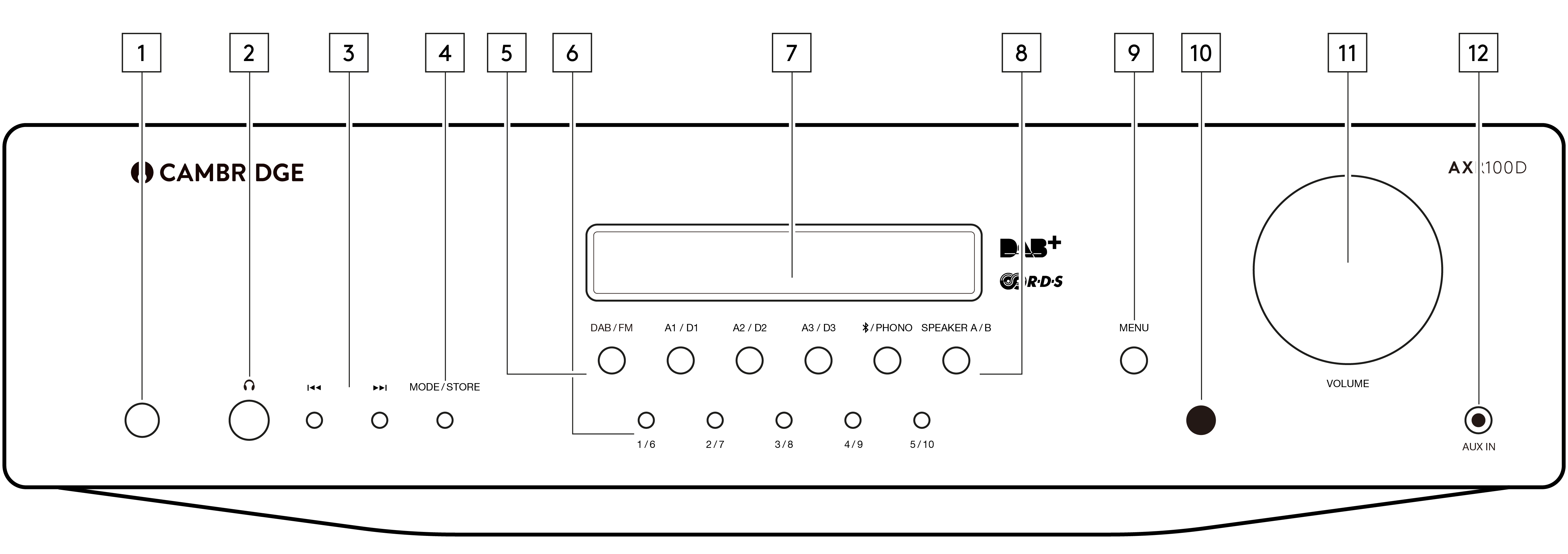
1. POWER BUTTON - Switches the unit between Standby mode (indicated by dim power LED) and On (indicated by bright power LED). Standby is a low power mode where the power consumption is less than 0.5 Watts. The unit can be left in Standby mode when not in use.
Auto Power Down (APD) – You can enable and disable the unit’s APD setting. This can be done by using the rotary dial to choose the ‘On’ or ‘Off’ option and then pressing the rotary dial to select the desired option.
Select the ‘Menu’ button > go to ‘APD Settings’ > set to ‘On’.
The product will then automatically switch to standby mode after inactivity of 20 minutes.
Note: Make sure the unit is On, before making changes to the APD function.
2. HEADPHONES SOCKET - Allows for the connection of stereo headphones with a quarter inch jack plug. Headphones with an impedance of between 32 and 600 ohms are recommended.
Note: Plugging in headphones will automatically mute the loudspeaker outputs.
3. SKIP/SCAN BUTTONS - The skip scan buttons are used when the DAB/FM tuner is selected. These buttons have different uses depending on the mode selected.
In Preset mode - Steps up or down through the user-stored presets.
In Auto mode - Searches for the previous or next available station. The unit stops at the next strong signal it finds.
In Manual mode - Allows manual stepping up or down of the frequency.
Note: When Preset mode is activated, the unit will automatically tune to the first available preset.
4. MODE/STORE BUTTON - Used for DAB/FM mode.
In FM: Press to cycle the tuning mode between Preset, Auto and Manual modes.
In DAB: Press to cycle between Auto scan, Preset and Service list modes.
Follow the ‘Storing Radio Presets’ guide in the ‘Operating Instructions’ section for full details on storing presets.
5. INPUT SOURCE BUTTONS (DIGITAL INPUTS D1, D2, D3) - Press the relevant source button to select the desired input source.
Note: There will be no sound from the receiver if the correct input source button isn’t selected.
6. PRESET BUTTONS - Used for DAB/FM modes. The preset buttons are used to select user-stored station presets.
- Pressing a preset button once will select one of the first 5 preset.
- Pressing and holding will select the later 5 presets.
- These presets are stored separately for each waveband i.e. there are 10 for FM and 10 for DAB. Press the DAB/FM button to switch between bands and sets of 10 presets.
Note: As well as these 10 per band available directly from the front panel buttons, a further thirty presets (11-40) per band can also be accessed by using the ‘Skip/Scan’ buttons to cycle through all 40 presets.
7. DISPLAY - Used to display information such as the selected input source, volume and tone/balance levels. When the FM or DAB tuner input is selected, the radio frequency or RDS station name will be displayed.
Note: When first purchased, the display will have a protective film over the top. Peel this off for a clear display.
8. SPEAKER A/B BUTTON - The Speaker A/B button toggles between the two sets of loudspeaker terminals. The options are speaker A only, speaker B only, speaker A and B together, and both sets of speakers off.
Note: ‘Speaker off’ is different to the mute function, as the Rec Out and Headphones outputs are still enabled.
9. MENU BUTTON - Pressing this once will display the menu item. Pressing a second time will return to the previous menu. The menu options are:
- System Info
- Tone Setting
- APD Setting
- Factory Reset
- Upgrade
The Treble, Bass and Balance options can be found in Tone setting. When one of these options is selected, the volume control will adjust the level.
If nothing is pressed for a while, the source will be displayed and the volume control will go back to controlling the volume level.
10. INFRARED SENSOR - Receives IR commands from the supplied remote control. An unobstructed line of sight between the remote control and the sensor is required.
11. VOLUME CONTROL - Use to increase or decrease the level of the sound from the outputs of the unit.
This controls the volume level of the loudspeakers, Sub-out and headphones.
Note: It does not affect the level of the ‘Rec Out’ output, as this has a fixed level.
The volume control will also change the level of Bass, Treble and Balance in the menu options.
12. AUX INPUT SOCKET - This source input allows you to connect a portable audio device, such as a smart phone directly into the front of the unit using a 3.5mm stereo-jack. Once plugged in, this input is automatically selected.